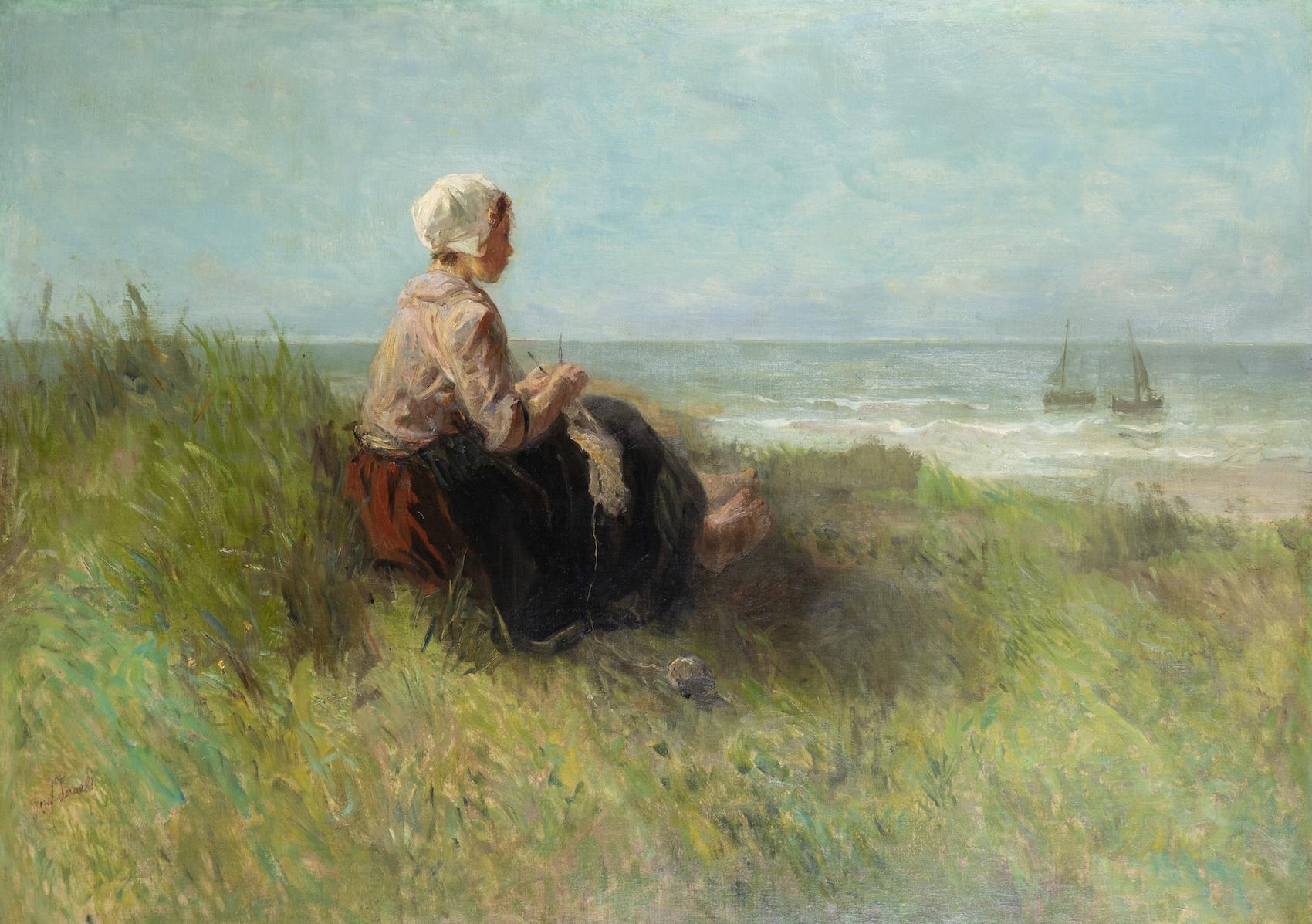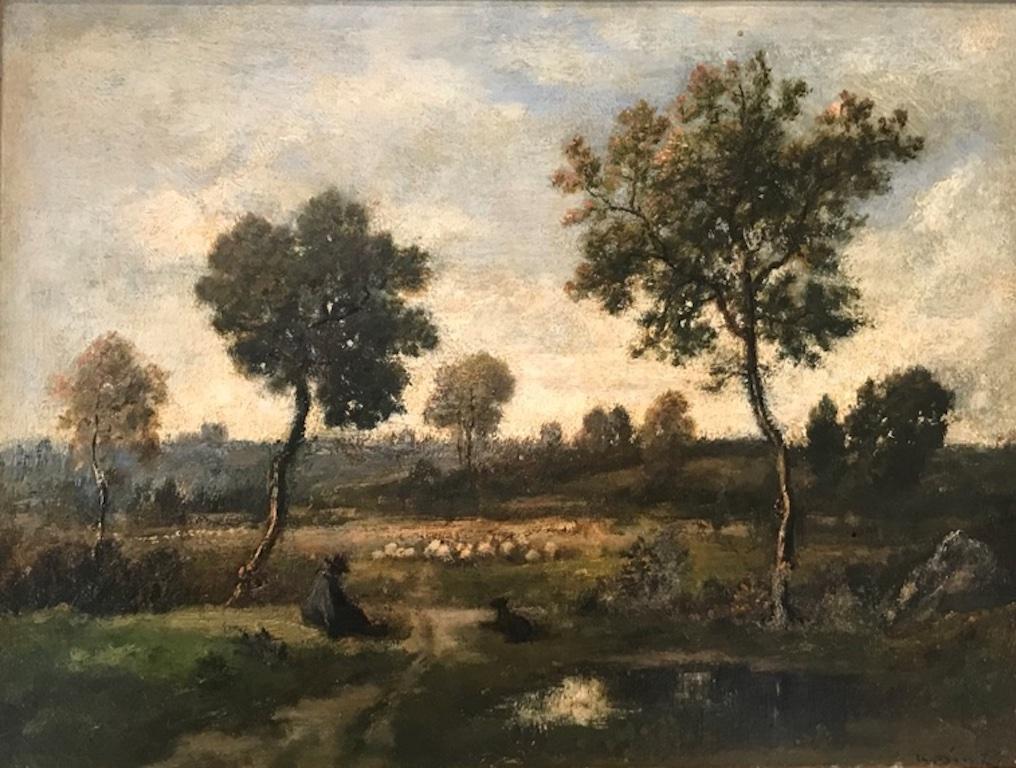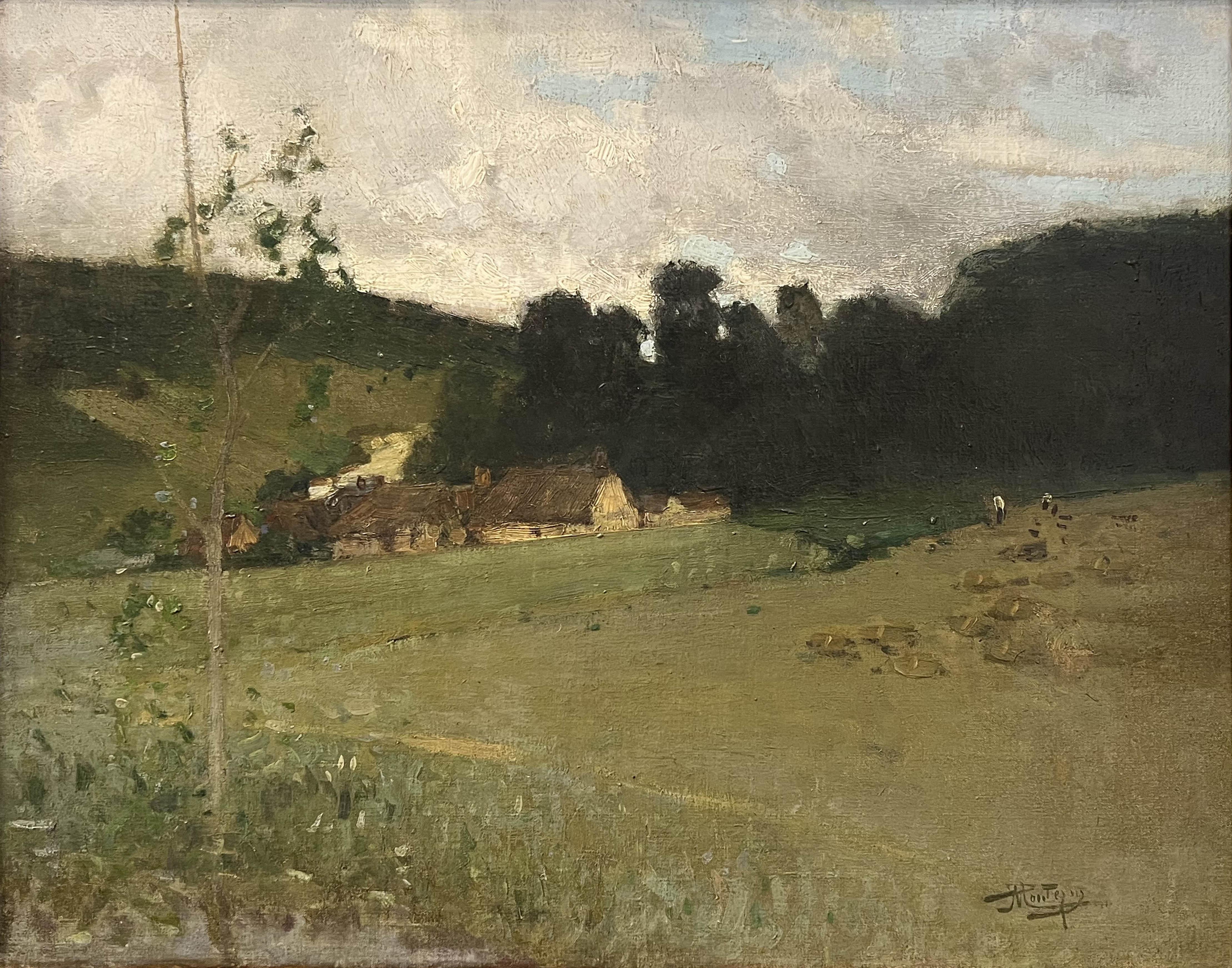Items Similar to Antique French Oil on Canvas Barbizon School Landscape Cows Victor Binet 1875
Want more images or videos?
Request additional images or videos from the seller
1 of 19
Victor BinetAntique French Oil on Canvas Barbizon School Landscape Cows Victor Binet 18751875
1875
About the Item
VICTOR JEAN BAPTISTE BARTHELEMY BINET
French, 1849-1924
This very attractive & early painting, circa 1875 by Binet, quintessentially defines the late Barbizon School period. Depicting a pair of cows in a bucolic landscape, one grazing and one resting, within a wooded area and a lake to the background. The painting is signed lower right "V. Binet" and is housed in the original lavishly gilded gesso frame, the painting and frame are in excellent condition, no damage or restoration.
Binet exhibited widely in France and London and was known as an established landscape painter of the time. Binet was exposed to the leading avant garde artists of his time and was greatly influenced by and worked with Constant Troyon, who along with Jules Dupre and Narcisse Diaz, formed the nucleus of the Barbizon School. The Barbizon School artists roamed the French countryside and the Fontainbleau Forest in search of rural environments for their subject matter. Their work was marked by herds of cows, sheep at their watering places and peasants tending to animals and farming. Stylistically, their brushwork used a heavy impasto and a palette that was centered on the natural dark greens of the forest, the earth colors of the soil and the kaleidoscopic colors of the sky. From the middle of the 1800s, Normandy, Brittany, Barbizon and Fontainebleau served as destinations for artists who were attempting to break away from the academic tradition of painting. They sought to leave the ateliers and work out-of-doors, en plein air. These areas, not so far from Paris, provided the beautiful country landscape of luscious, romantic forests and the hills and valleys that lead to the rugged coastline. Binet's work is highly collectable and can be found in public and private art collections across the world.
At Sight 16" width x 13" height X 1" depth
- Creator:Victor Binet (1849 - 1924, French)
- Creation Year:1875
- Dimensions:Height: 25 in (63.5 cm)Width: 28 in (71.12 cm)Depth: 3.25 in (8.26 cm)
- Medium:
- Movement & Style:
- Period:
- Condition:Both the frame and painting are in very good condition.
- Gallery Location:Portland, OR
- Reference Number:1stDibs: LU1366214146022
About the Seller
4.3
Gold Seller
These expertly vetted sellers are highly rated and consistently exceed customer expectations.
Established in 1990
1stDibs seller since 2020
22 sales on 1stDibs
- ShippingRetrieving quote...Ships From: Portland, OR
- Return PolicyA return for this item may be initiated within 14 days of delivery.
More From This SellerView All
- 19th century French Barbizon School Painting oil on Canvas Landscape circa 1840Located in Portland, OR19th century French Barbizon School Painting, oil on canvas signed "Marin", Circa 1840. A very attractive bucolic, pastoral landsacpe scene with sheep grazing on the banks of a lake ...Category
Early 19th Century Barbizon School Landscape Paintings
MaterialsOil, Canvas
- Antique American Oil on Canvas by Charles Holloway South American Landscape 1915Located in Portland, ORAntique American Oil on Canvas by Charles Holloway (American, 1859-1941), Circa 1915. The painting depicting a South American landscape scene, to the ...Category
Early 20th Century Realist Landscape Paintings
MaterialsCanvas, Oil
- French Oil on Canvas Michel Dureuil Street Scene New School of Paris 1948Located in Portland, ORFrench Oil on Canvas Post-Impressionist Painting "Street Scene," by Michel Dureuil, 1948. A fine and early painting by Michel Dureuil depicting a Parisi...Category
Mid-20th Century Impressionist Landscape Paintings
MaterialsOil, Canvas
- Antique Oil Painting William Weaver Armstrong Mount Hood Oregon Landscape 1885Located in Portland, ORA large oil on Canvas painting by the California artist William Weaver Armstrong (1862-1906), Mount Hood Oregon landscape, circa 1885. This large lan...Category
1880s American Realist Landscape Paintings
MaterialsCanvas, Oil
- Large Antique German Oil on Canvas Norwegian Fjord Landscape Scene 1890Located in Portland, ORA fine and Large oil on canvas painting by Karl Julius Rose (1828-1911), "Norwegian Fjord", signed and dated 1890. The artist also painted under the names;...Category
1890s Realist Landscape Paintings
MaterialsCanvas, Oil
- Antique American 19th C Realist California River Landscape Oil on Canvas 1888Located in Portland, ORA good late 19th century realist oil on canvas California river landscape painting, circa 1888, by Albert Horatio Slade (1843-1922). The painting depicts a river through a mountainou...Category
Late 19th Century Realist Landscape Paintings
MaterialsOil, Canvas
You May Also Like
- Waiting by Jozef Israëls - Landscape oil paintingBy Jozef IsraëlsLocated in London, GBWaiting by Jozef Israëls (1824-1911) Oil on canvas 95.3 x 133.9 cm (37 ½ x 52 ¾ inches) Signed lower left, Jozef Israels A monumental painting by one of...Category
19th Century Barbizon School Figurative Paintings
MaterialsCanvas, Oil
- The Forest, Large Barbizon School, Oil on Canvas Wooded LandscapeBy Emile Roux-FabreLocated in Cotignac, FRA French Barbizon School oil on canvas forest view by Emile Roux-Fabre. The painting is signed and dated bottom left with a dedication. A charming view of forest glade leading out to a valley landscape beyond. The artist has captured the magic feeling of the cool forest shade against the sunshine of the landscape beyond. The texture of the bark on the silver birch trees, the contrast of the leaves on the trees all framing the perspective to the view beyond. An extremely accomplished and atmospheric painting. The Barbizon school of painters was part of an art movement towards Realism in art, which arose in the context of the dominant Romantic Movement of the time. The Barbizon school was active roughly from 1830 through 1870. It takes its name from the village of Barbizon, France, on the edge of the Forest of Fontainebleau, where many of the artists gathered. Most of their works were landscape paintings, but several of them also painted landscapes with farmworkers, and genre scenes of village life. Some of the most prominent features of this school are its tonal qualities, colour, loose brushwork, and softness of form. The leaders of the Barbizon school were: Théodore Rousseau, Charles-François Daubigny, Jules Dupré, Constant Troyon, Charles Jacque, and Narcisse Virgilio Díaz. Jean-François Millet lived in Barbizon from 1849, but his interest in figures with a landscape backdrop sets him rather apart from the others. Jean-Baptiste-Camille Corot was the earliest on the scene, first painting in the forest in 1829, but his work has a poetic and literary quality which sets him somewhat apart. Other artists associated with the school, often pupils of the main group, include: Henri Harpignies, Albert Charpin, François-Louis Français and Émile van Marcke. In 1824 the Salon de Paris exhibited works of John Constable, an English painter. His rural scenes influenced some of the younger artists of the time, moving them to abandon formalism and to draw inspiration directly from nature. Natural scenes became the subjects of their paintings rather than mere backdrops to dramatic events. During the Revolutions of 1848 artists gathered at Barbizon to follow Constable's ideas, making nature the subject of their paintings. The French landscape became a major theme of the Barbizon painters. Millet extended the idea from landscape to figures — peasant figures, scenes of peasant life, and work in the fields. In The Gleaners (1857), for example, Millet portrays three peasant women working at the harvest. Gleaners are poor people who are permitted to gather the remains after the owners of the field complete the main harvest. The owners (portrayed as wealthy) and their laborers are seen in the back of the painting. Millet shifted the focus and the subject matter from the rich and prominent to those at the bottom of the social ladders. To emphasize their anonymity and marginalized position, he hid their faces. The women's bowed bodies represent their everyday hard work. In the spring of 1829, Jean-Baptiste-Camille Corot came to Barbizon to paint in the Forest of Fontainebleau, he had first painted in the forest at Chailly in 1822. He returned to Barbizon in the autumn of 1830 and in the summer of 1831, where he made drawings and oil studies, from which he made a painting intended for the Salon of 1830; "View of the Forest of Fontainebleau'" (now in the National Gallery in Washington) and, for the salon of 1831, another "View of the Forest of Fontainebleau"'. While there he met the members of the Barbizon school: Théodore Rousseau, Paul Huet, Constant Troyon, Jean-François Millet, and the young Charles-François Daubigny. During the late 1860s, the Barbizon painters attracted the attention of a younger generation of French artists studying in Paris. Several of those artists visited Fontainebleau Forest to paint the landscape, including Claude Monet, Pierre-Auguste Renoir, Alfred Sisley and Frédéric Bazille. In the 1870s those artists, among others, developed the art movement called Impressionism and practiced 'plein air' painting. In contrast, the main members of the school made drawings and sketches on the spot, but painted back in their studios. The Post-Impressionist painter Vincent Van Gogh studied and copied several of the Barbizon painters as well, including 21 copies of paintings by Millet. He copied Millet more than any other artist. He also did three paintings in Daubigny's Garden. The Barbizon painters also had a profound impact on landscape painting in the United States. This included the development of the American Barbizon school by William Morris Hunt. Several artists who were also in, or contemporary to, the Hudson River School studied Barbizon paintings for their loose brushwork and emotional impact. A notable example is George Inness, who sought to emulate the works of Rousseau. Paintings from the Barbizon school also influenced landscape painting in California. The artist Percy Gray...Category
Early 20th Century Barbizon School Landscape Paintings
MaterialsCanvas, Oil
- River Cottage 1849/ Barbizon landscape heralding Impressionism Jongkind's friendBy Henri SieuracLocated in Norwich, GBA wonderful view of a river landscape with a rustic cottage and pollarded trees by Henri Sieurac. It isa rare, early and very fresh landscape by this Parisian artist which may well have been painted in the countryside around Barbizon, near the river Loing. Henry Sieurac had studied with his father, François Joseph Sieurac , and of Paul Delaroche...Category
1840s Barbizon School Landscape Paintings
MaterialsOil, Canvas
- Troupeau de moutons dans la clairièreBy Narcisse Virgilio Díaz de la PeñaLocated in Barbizon, FROil on canvas 24.5 x 32.5 cm, signed lower right Provenance: Sale Galerie Boussod-Valadon & Allard, Paris, 03/03/1919, Georges Petit Hotel Drouot Ferri Sale 05/06/2019 lot no 18 L...Category
19th Century Barbizon School Landscape Paintings
MaterialsCanvas, Oil
- Au bord d'un ruisseauBy Léon-Victor DupréLocated in Barbizon, FROil on canvas 32.5x55.1 cm. Signed in the lower left and dated 1855. Origin: - Christie's New York sale on February 15, 1985 - Rindoko Museum in Tochigi, Japan - Special collection ...Category
19th Century Barbizon School Landscape Paintings
MaterialsOil, Canvas
- Paysage à Muzy sur Avre (Normandie)By Pierre Eugène MontezinLocated in Barbizon, FROil on canvas, signed in the bottom right corner His father was a lace designer and set him up to work in adecoration workshop. Later, he became heavily influenced by impressionist ...Category
Early 20th Century Barbizon School Landscape Paintings
MaterialsCanvas, Oil
Recently Viewed
View AllMore Ways To Browse
France 1870 Art
Victor Antique
Antique Search
Pair Of Antique Landscapes
Antique Painting Art Collectibles
Cows Landscape
Cows In Landscape
Pair Oil Landscape Paintings
Cow Oil
Antique French Country Paintings
Cow Landscape Painting
Landscape With Cows
Landscape With A Cow
French Landscape 1870
Barbizon School Of Painting
Signed Cow Painting
Barbizon Oil Painting
Barbizon Oil




